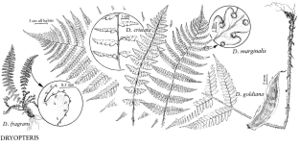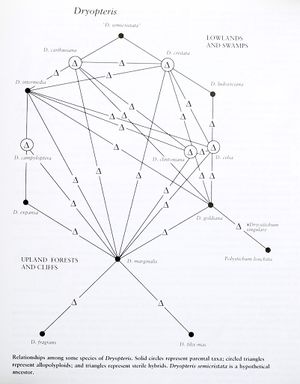Dryopteris
Fam. Pl. 2: 20, 551. 1763.
Plants terrestrial, rarely on rock. Stems short-creeping to erect, stolons absent. Leaves monomorphic, green through winter or dying back in winter. Petiole ca. 1/4–2/3 blade length, bases swollen or not; vascular-bundles more than 3, arranged in an arc, ± round in cross-section. Blade deltate-ovate to lanceolate, 1–3-pinnate-pinnatifid, gradually reduced distally to pinnatifid apex, herbaceous to somewhat leathery. Pinnae not articulate to rachis, segment margins entire, crenate, or serrate, spinulose or not; proximal pinnae reduced (several pairs), same size as or enlarged relative to more distal pinnae, sessile to petiolulate, equilateral or often inequilateral with pinnules on basiscopic side longer than those on acroscopic side; costae adaxially grooved, grooves continuous from rachis to costae to costules; indument of linear to ovate scales abaxially, also sometimes with glands, blades ± glabrous adaxially. Veins free, forked. Sori in 1 row between margin and midrib, round; indusia round-reniform, attached at narrow sinus, persistent or caducous. Spores brownish, coarsely rugose or with folded wings. x = 41.
Distribution
Mostly in temperate Asia
Discussion
The relationships of the North American species are reasonably well understood, but species identifications are complicated by the frequent presence of hybrids in field populations. Sterile hybrids can be distinguished from fertile species by their misshapen spores and intermediate morphology. They are not included in the key, but they may be identified as to parentage by combinations of characters in the key (e.g., marginal sori for Dryopteris marginalis, narrow blades for D. cristata). Relationships are shown in the accompanying reticulogram.
Species ca. 250 (14 in the flora).
Selected References
Lower Taxa
Key
| 1 | Blades densely scaly abaxially, aromatic-glandular; old leaves forming conspicuous gray or brown clumps; leaves 6-25(-40) cm. | Dryopteris fragrans |
| 1 | Blades glabrous to sparsely scaly abaxially, not aromatic-glandular; old leaves not persisting in conspicuous gray or brown clumps; leaves usually more than 25 cm. | > 2 |
| 2 | Blades 2-pinnate to 3-pinnate-pinnatifid at base. | > 3 |
| 2 | Blades pinnate-pinnatifid to 2-pinnate at base. | > 7 |
| 3 | Basal pinnules of basal pinnae shorter than adjacent pinnules. | > 4 |
| 3 | Basal pinnules of basal pinnae longer than adjacent pinnules. | > 5 |
| 4 | Pinnae with elongate serrate tip; blades and indusia lacking glands or sparsely glandular. | Dryopteris cinnamomea |
| 4 | Pinnae lacking elongate serrate tip; blades, at least the midrib of segments and indusia, finely glandular. | Dryopteris intermedia |
| 5 | First basal basiscopic pinnule not much wider than 1st acroscopic pinnule on basal pinnae; blades ovate-lanceolate. | Dryopteris carthusiana |
| 5 | First basal basiscopic pinnule 2 times width of 1st acroscopic pinnule on basal pinnae; blades ovate-deltate. | > 6 |
| 6 | Petiole scales tan, with dark central stripe; leaves erect to slightly arching (Rocky Mountains, n Great Lakes, ne Canada). | Dryopteris expansa |
| 6 | Petiole scales tan or dark at base, lacking distinct dark stripe; leaves widely spreading (Appalachian Mountains north to ne Canada). | Dryopteris campyloptera |
| 7 | Sori at or near margins of segments; petioles with dense tuft of pale tawny scales at base. | Dryopteris marginalis |
| 7 | Sori midway between margin and midrib or closer to midribs of segments; petioles with scattered tan to dark brown scales at base. | > 8 |
| 8 | Pinnules finely spiny with spreading teeth (Arizona and west coast of North America). | Dryopteris arguta |
| 8 | Pinnules not finely spiny, teeth blunt or incurved (e, nw North America). | > 9 |
| 9 | Petioles less than 1/4 length of leaves, scales of 2 kinds, mixed, broad and hairlike. | Dryopteris filix-mas |
| 9 | Petioles 1/4-1/3 length of leaves, scales broad to narrow, but not hairlike. | > 10 |
| 10 | Fertile pinnae narrower than vegetative pinnae, restricted to distal 1/2 of blade. | Dryopteris ludoviciana |
| 10 | Fertile pinnae same width as vegetative pinnae, occupying distal 1/2 of blade to nearly entire blade. | > 11 |
| 11 | Basal pinnae ovate; blades ovate to ovate-lanceolate; scales at base of petioles dark brown or with dark brown stripe. | > 12 |
| 11 | Basal pinnae deltate; blades lanceolate with parallel sides; scales at base of petioles tan. | > 13 |
| 12 | Blades ovate, tapering abruptly to tip; sori nearer midvein than margin of segments. | Dryopteris goldieana |
| 12 | Blades ovate-lanceolate, gradually narrowed to tip; sori about midway between midvein and margin of segments. | Dryopteris celsa |
| 13 | Basal pinnae narrowly elongate-deltate; pinnae of fertile leaves nearly in plane of blade. | Dryopteris clintoniana |
| 13 | Basal pinnae deltate; pinnae of fertile leaves twisted nearly at right angles to plane of blade. | Dryopteris cristata |
"not" is not a number. "swollen" is not a number.


